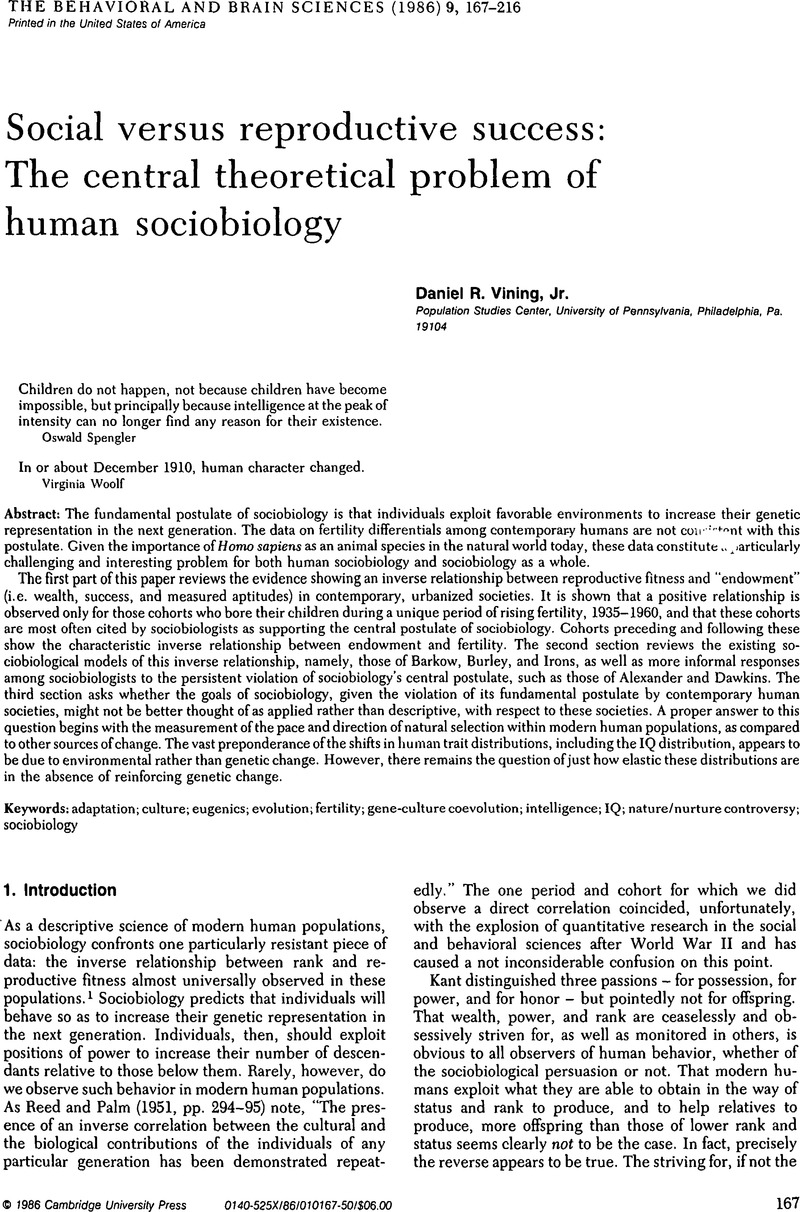Crossref Citations
This article has been cited by the following publications. This list is generated based on data provided by Crossref.
Vining, Daniel R.
1987.
Modern human sociobiology: Some further observations.
Behavioral and Brain Sciences,
Vol. 10,
Issue. 2,
p.
308.
Machalek, Richard
1987.
Are the socially successful an intelligence cartel?.
Behavioral and Brain Sciences,
Vol. 10,
Issue. 2,
p.
307.
Cattell, Raymond B.
1987.
Fitness and intelligence: The more concrete problem.
Behavioral and Brain Sciences,
Vol. 10,
Issue. 2,
p.
305.
Flinn, Mark V.
1987.
Resources, reproduction, and mate competition in human populations.
Behavioral and Brain Sciences,
Vol. 10,
Issue. 2,
p.
305.
Shaw, R. Paul
and
Wong, Yuwa
1989.
Keys to a Unified Theory of Warfare and Arms Races.
Politics and the Life Sciences,
Vol. 7,
Issue. 2,
p.
209.
Symons, Donald
1989.
A critique of Darwinian anthropology.
Ethology and Sociobiology,
Vol. 10,
Issue. 1-3,
p.
131.
Roberts, Joseph Palmer
1990.
The sociobiology of ethnocentrism in an Indian City.
Ethology and Sociobiology,
Vol. 11,
Issue. 6,
p.
465.
Daly, Martin
and
Wilson, Margo
1991.
A reply to Gelles: Stepchildrenare disproportionately abused, and diverse forms of violencecan share causal factors.
Human Nature,
Vol. 2,
Issue. 4,
p.
419.
Walters, Sally
1994.
Algorithms and archetypes: Evolutionary psychology and Carl Jung's theory of the collective unconscious.
Journal of Social and Evolutionary Systems,
Vol. 17,
Issue. 3,
p.
287.
Irons, William
1998.
Adaptively relevant environments versus the environment of evolutionary adaptedness.
Evolutionary Anthropology: Issues, News, and Reviews,
Vol. 6,
Issue. 6,
p.
194.
Gaulin, Steven J.C.
and
Fessler, Daniel M.T.
2010.
In Memoriam: Margo Ings Wilson.
Evolution and Human Behavior,
Vol. 31,
Issue. 1,
p.
1.
Block, Carolyn Rebecca
and
Rasche, Christine E.
2012.
Introduction to the Special Issue.
Homicide Studies,
Vol. 16,
Issue. 4,
p.
315.
Pietraszewski, David
and
Wertz, Annie E.
2022.
Why Evolutionary Psychology Should Abandon Modularity.
Perspectives on Psychological Science,
Vol. 17,
Issue. 2,
p.
465.



